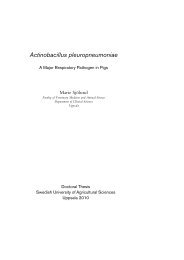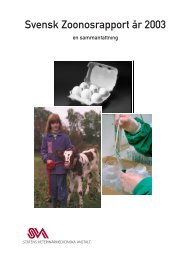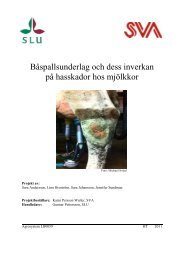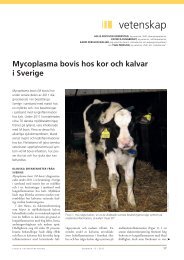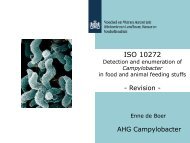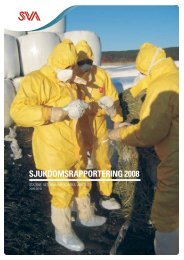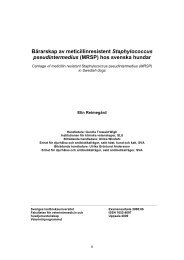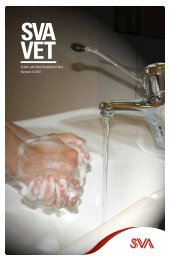MicroVal validation of a Campylobacter enumeration medium - SVA
MicroVal validation of a Campylobacter enumeration medium - SVA
MicroVal validation of a Campylobacter enumeration medium - SVA
Create successful ePaper yourself
Turn your PDF publications into a flip-book with our unique Google optimized e-Paper software.
1<br />
<strong>MicroVal</strong> <strong>validation</strong> <strong>of</strong><br />
a <strong>Campylobacter</strong><br />
<strong>enumeration</strong> <strong>medium</strong><br />
Method Comparison Study and<br />
Interlaboratory Study results<br />
Wilma Jacobs, EU-RL <strong>Campylobacter</strong> Workshop 2010
Why <strong>validation</strong> <strong>of</strong> alternative methods?<br />
● EU Microbiological Criteria Document<br />
(Commission Regulation (EC) No 2073/2005, on microbiological criteria for<br />
foodstuffs)<br />
● Article 5 - Specific rules for testing and sampling<br />
● Use <strong>of</strong> alternative methods is acceptable, when the method<br />
has been validated against the reference method and<br />
certified by a third party according to EN/ISO 16140 (or<br />
other similar internationally accepted protocols).<br />
2<br />
Wilma Jacobs, EU-RL <strong>Campylobacter</strong> Workshop October 2010
ISO 16140 <strong>validation</strong>: what is involved<br />
● EN ISO 16140:2003 „Microbiology <strong>of</strong> food and animal feeding<br />
stuffs - Protocol for the <strong>validation</strong> <strong>of</strong> alternative methods‟<br />
● EN ISO 16140:2003/Draft Amd 1:2009. Amendment 1:<br />
Interlaboratory study on quantitative methods<br />
● At the moment in a process <strong>of</strong> revision<br />
3<br />
– Experiences from the 2003 version<br />
– New version split up in 5 parts<br />
– First drafts for comments in May 2009<br />
– May still take some years…<br />
Wilma Jacobs, EU-RL <strong>Campylobacter</strong> Workshop October 2010
Validation process<br />
● Information exchange (client, MV)<br />
● Application (client)<br />
● Contracts (client-MCB, client-EL, MCB-EL)<br />
● Project proposal (EL)<br />
– Method Reviewers<br />
– Technical Committee<br />
– Approval<br />
● Project report (by EL, in 2 parts: MCS + ILS)<br />
– Method Reviewers<br />
– Technical Committee<br />
– Approval<br />
● Certificate (MCB)<br />
4<br />
Wilma Jacobs, EU-RL <strong>Campylobacter</strong> Workshop October 2010
ISO 16140:2003 <strong>validation</strong><br />
● Alternative method description (e.g. the “kit insert”)<br />
● Reference method (ISO)<br />
● Scope <strong>of</strong> the <strong>validation</strong><br />
● E.g.: “All foods and animal feed”<br />
5<br />
– A minimum <strong>of</strong> 5 Categories to be tested (Annex B, ISO 16140)<br />
› Meat products, poultry products, fish & seafood products, fruits and vegetable<br />
based products, dairy products, chocolate/bakery products, other products,<br />
animal feeds<br />
– Additional Categories: environmental samples, samples from the<br />
primary production stage.<br />
● One specific Category, e.g. “Poultry Products”, is also possible<br />
Wilma Jacobs, EU-RL <strong>Campylobacter</strong> Workshop October 2010
ISO 16140:2003 <strong>validation</strong><br />
Qualitative method <strong>validation</strong> (Detection)<br />
● A. Methods comparison study:<br />
– Relative accuracy, relative specificity and relative sensitivity<br />
› 60 samples per Category<br />
– Relative detection level<br />
› 6 samples at 3-5 levels per Category<br />
– Inclusivity and exclusivity<br />
› 50 target strains and 30 non-target strains to be tested<br />
● B. Interlaboratory study:<br />
– At least 10 collaborative laboratories within 3 (European)<br />
countries<br />
› 8 replicates at 3 levels = 24 samples by each laboratory<br />
6<br />
Wilma Jacobs, EU-RL <strong>Campylobacter</strong> Workshop October 2010
ISO 16140:2003 <strong>validation</strong><br />
Quantitative method <strong>validation</strong> (Enumeration)<br />
● A. Methods comparison study:<br />
– Linearity and relative accuracy<br />
› Per Category at least 1 sample in duplicate at 5 different levels<br />
– Relative sensitivity and determination <strong>of</strong> unknown samples<br />
› Per Category at least 10 additional samples in duplicate<br />
– Detection and quantification limits<br />
› 6 replicates <strong>of</strong> at least 3 levels<br />
– Specificity, inclusivity and exclusivity<br />
› 30 target strains and 20 non-target strains to be tested<br />
● B. Interlaboratory study:<br />
– At least 8 collaborative laboratories within 3 (European) countries<br />
› 2 replicates at 4 levels = 8 samples by each laboratory<br />
7<br />
Wilma Jacobs, EU-RL <strong>Campylobacter</strong> Workshop October 2010
Microval Expert Laboratory (EL)<br />
● Organisation and elaboration <strong>of</strong> the lab work<br />
8<br />
– Methods Comparison Study<br />
– Interlaboratory Study<br />
● To be chosen by the client<br />
● List <strong>of</strong> labs available at www.microval.org<br />
● Labs qualifications<br />
– Officially approved by <strong>MicroVal</strong><br />
– Accreditation (eg ISO 17025)<br />
– Confidentiality<br />
● Collaborative laboratories for participation in the ILS:<br />
– Contacted by the EL<br />
– Preferably working under a QA system (eg ISO 17025)<br />
Wilma Jacobs, EU-RL <strong>Campylobacter</strong> Workshop October 2010
RIKILT Institute <strong>of</strong> Food Safety, Wageningen, NL<br />
9<br />
Wilma Jacobs, EU-RL <strong>Campylobacter</strong> Workshop October 2010
RIVM, Bilthoven, NL<br />
National Institute for Public Health and the Environment<br />
10<br />
Wilma Jacobs, EU-RL <strong>Campylobacter</strong> Workshop October 2010
Example: Enumeration <strong>of</strong> <strong>Campylobacter</strong><br />
● Confidentiality? (the client agrees, and the certificate is granted!)<br />
● Example <strong>of</strong> the quantitative <strong>validation</strong> process<br />
– Expert Lab: RIKILT Institute <strong>of</strong> Food Safety<br />
– Certification Body: Lloyds Register<br />
– Method reviewers: Henk Stegeman & Basil Jarvis<br />
● Alternative method: Oxoid Brilliance CampyCount Agar plate for<br />
<strong>enumeration</strong> <strong>of</strong> <strong>Campylobacter</strong> species in poultry meat products,<br />
with confirmation according to the reference method, and also with<br />
confirmation using the O.B.I.S Campy kit or the Dryspot<br />
<strong>Campylobacter</strong> Test.<br />
● Reference method: ISO-TS 10272-2:2006 Microbiology <strong>of</strong> food<br />
and animal feeding stuffs – Horizontal method for detection and<br />
<strong>enumeration</strong> <strong>of</strong> <strong>Campylobacter</strong> spp. Part 2: Colony-count technique.<br />
● Food Category: Poultry products.<br />
11<br />
Wilma Jacobs, EU-RL <strong>Campylobacter</strong> Workshop October 2010
Brilliance CampyCount Agar (BCCA)<br />
● a newly developed defined<br />
<strong>medium</strong> for the selective<br />
<strong>enumeration</strong> <strong>of</strong> thermotolerant<br />
<strong>Campylobacter</strong> species, in<br />
particular C. jejuni and C. coli,<br />
in poultry products. After<br />
micro-aerobic incubation for<br />
48 hours at 41.5 C,<br />
characteristic campylobacters<br />
appear as red colonies on the<br />
clear agar background.<br />
12<br />
Wilma Jacobs, EU-RL <strong>Campylobacter</strong> Workshop October 2010
13<br />
Wilma Jacobs, EU-RL <strong>Campylobacter</strong> Workshop October 2010
14<br />
Per dilution:<br />
2 x 0,1 ml on 2 mCCDA plates<br />
10 gram test portion + 90 ml peptone-salt solution<br />
10-fold dilution series in 9 ml peptone-salt solution tubes<br />
Microaerobic* incubation<br />
40-48 hours at 41,5 °C<br />
Counting <strong>of</strong> characteristic colonies<br />
Confirmation <strong>of</strong> 5 characteristic colonies per plate**<br />
Per dilution:<br />
2 x 0,1 ml on 2 BCCA plates<br />
Wilma Jacobs, EU-RL <strong>Campylobacter</strong> Workshop October 2010
*Microaerobic incubation in gas jars, using the appropriate Oxoid Campygen atmosphere sachets.<br />
**The duplicate plates <strong>of</strong> the best countable dilution per sample.<br />
15<br />
Counting <strong>of</strong> characteristic colonies<br />
Confirmation <strong>of</strong> 5 characteristic colonies per plate**<br />
Purification on Columbia blood agar<br />
-Microscopy for morphology and motility<br />
-Oxidase test<br />
-Growth at 41,5 °C, aerobic<br />
-Growth at 25 °C, microaerobic*<br />
-O.B.I.S Campy kit (Oxoid ID 0800M)<br />
-Dryspot <strong>Campylobacter</strong> test (DR0150M)<br />
Wilma Jacobs, EU-RL <strong>Campylobacter</strong> Workshop October 2010
Methods Comparison Study<br />
● Linearity and relative accuracy<br />
16<br />
– Per Category at least 1 sample in duplicate at 5 different<br />
levels<br />
– The concentration range in the samples tested should<br />
cover a minimum (zero or otherwise), a central, a<br />
maximum, and two intermediary levels.<br />
● In this study 5 different concentration levels (in cfu/g) were<br />
chosen, intended to be circa 150, 500, 1500, 5000, and<br />
50.000.<br />
● Chicken breast skin: C. jejuni strain C145<br />
● Poultry minced meat: C. coli strain C161<br />
Wilma Jacobs, EU-RL <strong>Campylobacter</strong> Workshop October 2010
Methods Comparison Study<br />
● Relative sensitivity and determination <strong>of</strong> unknown samples<br />
17<br />
– Per Category at least 10 additional samples in duplicate<br />
● Category “Poultry products”<br />
● Food types tested:<br />
– chicken and turkey fillet samples (pieces),<br />
– chicken skin samples from breast/thigh/leg,<br />
– chicken liver samples,<br />
– chicken minced meat samples.<br />
● A total <strong>of</strong> 103 raw poultry products were tested<br />
Wilma Jacobs, EU-RL <strong>Campylobacter</strong> Workshop October 2010
Example <strong>of</strong> skin sample result on mCCDA and BCCA<br />
18<br />
Wilma Jacobs, EU-RL <strong>Campylobacter</strong> Workshop October 2010
Methods Comparison Study<br />
● 103 raw poultry meat samples<br />
– 57 samples did not contain <strong>Campylobacter</strong> in detectable numbers (< 20<br />
cfu/g)<br />
– 15 samples only contained <strong>Campylobacter</strong> in very low levels (less than 10<br />
cfu per plate)<br />
● Statistical evaluation:<br />
– 31 naturally contaminated samples in duplicate<br />
– 11 artificially contaminated samples in duplicate<br />
● The naturally and artificially contaminated samples did not behave<br />
differently in the comparison.<br />
● For the products minced meat, chicken skin, chicken liver, chicken breast<br />
skin, there was a good agreement between the methods:<br />
– no significant bias and no significant deviation from linearity<br />
● For the product chicken thigh skin, however, there was a significant<br />
systematic bias between the methods (BCCA finds lower results than<br />
mCCDA).<br />
19<br />
Wilma Jacobs, EU-RL <strong>Campylobacter</strong> Workshop October 2010
20<br />
BCCA<br />
6<br />
5<br />
4<br />
3<br />
2<br />
1<br />
1 2 3 4 5 6<br />
mCCDA<br />
Figure 1. Calculated regression line y = -0,14 + 1,05 x with 95% confidence<br />
limits for all poultry products, except for chicken thigh skin samples.<br />
naturally contaminated samples artificially contaminated samples.<br />
Wilma Jacobs, EU-RL <strong>Campylobacter</strong> Workshop October 2010
Methods Comparison Study<br />
● Detection and quantification limits<br />
21<br />
– 6 replicates <strong>of</strong> at least 3 levels<br />
● Fresh overnight culture <strong>of</strong> C. jejuni strain C145<br />
● Three test levels: an unspiked blank, and a lower and higher level<br />
● Plating 0,1 ml portions on to BCCA plates<br />
● 6 replicates per level<br />
● The detection and quantification limits are calculated according to<br />
clause 6.2.2 <strong>of</strong> ISO 16140 on the basis <strong>of</strong> threshold spread S 0.<br />
● Calculate: S 0 = 0,8 colonies/plate.<br />
● Detection limit LOD = 3 colonies/plate.<br />
● Quantification limit LOQ = 10 colonies/plate.<br />
Wilma Jacobs, EU-RL <strong>Campylobacter</strong> Workshop October 2010
Methods Comparison Study<br />
● Specificity, inclusivity and exclusivity<br />
– 30 target strains and 20 non-target strains to be tested<br />
● A total <strong>of</strong> 37 <strong>Campylobacter</strong> strains were tested for inclusivity.<br />
● A total <strong>of</strong> 21 non-<strong>Campylobacter</strong> strains were tested for exclusivity.<br />
● Overnight cultures <strong>of</strong> strains<br />
– in Brain Heart Infusion (BHI) for <strong>Campylobacter</strong><br />
– in Buffered Peptone Water (BPW) for non-<strong>Campylobacter</strong><br />
– Dilutions in peptone saline to contain > 100 times the limit <strong>of</strong><br />
detection (so: > 100 CFU/ml).<br />
– No matrix added.<br />
● The cell cultures were tested in duplicate with both the reference<br />
and alternative method by plating out 0,1 ml portions <strong>of</strong> the<br />
appropriate dilutions.<br />
22<br />
Wilma Jacobs, EU-RL <strong>Campylobacter</strong> Workshop October 2010
MCS, strains for inclusivity<br />
Strain Ref nr. Origin Source Strain Ref nr. Origin Source<br />
C. coli C 18 NCTC 11366 (ATCC 33559) C. jejuni C 09 Finland turkey (cecal)<br />
C. coli C 19 The Netherlands chicken legs C. jejuni C 10 Belgium poultry minced meat<br />
C. coli C 20 The Netherlands chicken neck skin C. jejuni C 11 Belgium chicken fillet<br />
C. coli C 21 The Netherlands chicken caecum C. jejuni C 12 Belgium chicken breast skin<br />
C. coli C 22 Belgium chicken breast skin C. jejuni C 13 Belgium chicken neck skin<br />
C. coli C 23 Belgium chicken neck skin C. jejuni C 14 UK poultry<br />
C. coli C 24 Belgium poultry minced meat C. jejuni C 15 The Netherlands poultry<br />
C. coli C 25 Belgium chicken fillet C. jejuni C 16 Denmark poultry<br />
C. coli C 34 ATCC 43478 (LMG 21266) C. jejuni C 17 Finland marinated broiler meat<br />
C. coli C 35 The Netherlands Chicken neck skin C. jejuni C 31 Finland marinated broiler meat<br />
C. hyointestinalis C 30 Ireland poultry C. jejuni C 32 Belgium chicken<br />
C. jejuni C 01 ATCC 33291 (LMG 18455) C. jejuni C 33 The Netherlands chicken breast skin<br />
C. jejuni C 03 NCTC 11351 (ATCC 33560) C. jejuni subsp. doylei C 02 NCTC 11951 (LMG 8843)<br />
C. jejuni C 04 Finland turkey (fecal) C. lari C 26 NCTC 11352<br />
C. jejuni C 05 The Netherlands chicken legs C. lari C 27 The Netherlands raw oysters<br />
C. jejuni C 06 The Netherlands poultry C. lari C 28 The Netherlands surface water<br />
C. jejuni C 07 The Netherlands chicken neck skin C. upsaliensis C 29 NCTC 11541 (LMG 8850)<br />
C. jejuni C 08 The Netherlands chicken caecum C. upsaliensis C 36 LMG 9124<br />
C. upsaliensis C 37 CCUG 14913<br />
23<br />
Wilma Jacobs, EU-RL <strong>Campylobacter</strong> Workshop October 2010
MCS, inclusivity results<br />
● All 19 C. jejuni subsp. jejuni strains showed typical growth on both<br />
mCCDA and BCCA plates.<br />
● All 10 C. coli strains showed typical growth on both mCCDA and<br />
BCCA plates.<br />
● The C. jejuni subsp. doylei strain did not grow on either <strong>of</strong> the<br />
plates, as could be expected because <strong>of</strong> the incubation temperature<br />
<strong>of</strong> 41,5 C.<br />
● 3 C. upsaliensis strains and 1 C. hyointestinalis strain tested, did<br />
not grow on mCCDA or BCCA.<br />
● One <strong>of</strong> the C. lari strains failed to grow on BCCA but did grow on<br />
mCCDA. The remaining two C. lari strains did grow on both mCCDA<br />
and BCCA.<br />
● Note that BCCA plates are intended for counting in particular C.<br />
jejuni and C. coli.<br />
24<br />
Wilma Jacobs, EU-RL <strong>Campylobacter</strong> Workshop October 2010
MCS, strains for exclusivity<br />
25<br />
Strain Ref nr. Origin Source<br />
Acinetobacter baumannii NS 1 DSM 30007 Urine, type strain<br />
Acinetobacter calcoaceticus NS 2 The Netherlands Milk<br />
Aeromonas hydrophila NS 3 ATCC 7966<br />
Arcobacter butzleri NS 4 The Netherlands Poultry<br />
Candida albicans NS 5 The Netherlands Poultry meat<br />
Citrobacter freundii NS 6 Food<br />
Enterobacter cloacae NS 7 The Netherlands Environment<br />
Enterococcus faecalis NS 8 NCTC 775 (ATCC 19433)<br />
Enterococcus hirae NS 9 LMG 6399 Food<br />
Escherichia coli NS 10 NCTC 9001 (ATCC 11775)<br />
Escherichia coli NS 11 The Netherlands Poultry meat<br />
Escherichia coli NS 12 Belgium Poultry meat<br />
Escherichia coli NS 21 CHEK 3E-0808<br />
Klebsiella oxytoca NS 13 Cheese<br />
Proteus mirabilis NS 14 Shampoo<br />
Pseudomonas aeruginosa NS 15 ATCC 27853<br />
Saccaromyces cerevisiae NS 16 ATCC 9080<br />
Salmonella Typhimurium NS 17 The Netherlands Poultry meat<br />
Shigella flexneri NS 18 ATCC 12022<br />
Staphylococcus aureus NS 19 ATCC 25923<br />
Vibrio alginolyticus NS 20 The Netherlands Oysters<br />
Wilma Jacobs, EU-RL <strong>Campylobacter</strong> Workshop October 2010
MCS, exclusivity results<br />
● 19 out <strong>of</strong> the 21 non-<strong>Campylobacter</strong> strains gave a negative<br />
result (no growth at all) using mCCDA and BCCA.<br />
● The Acinetobacter baumanii strain and one <strong>of</strong> the four E. coli<br />
strains (an ESBL-producing isolate) did show growth on both<br />
mCCDA and BCCA plates.<br />
● On mCCDA this growth was atypical (white versus grey<br />
colonies).<br />
● On BCCA plates the growth was typical (red colonies).<br />
However, confirmation tests (microscopy, Dryspot, O.B.I.S)<br />
readily indicated these strains not to be <strong>Campylobacter</strong>.<br />
26<br />
Wilma Jacobs, EU-RL <strong>Campylobacter</strong> Workshop October 2010
The Method Comparison Study conclusions are:<br />
● There is good agreement between the reference method and the<br />
alternative method: there is no significant bias between the<br />
methods and the relation between the methods does not deviate<br />
significantly from linearity.<br />
● For the alternative method the detection limit LOD = 3<br />
colonies/plate. The quantification limit LOQ = 10 colonies/plate.<br />
● The alternative method, particularly intended for <strong>enumeration</strong> <strong>of</strong> C.<br />
jejuni and C. coli, is selective and specific, as concluded from the<br />
inclusivity and exclusivity results.<br />
● These conclusions are valid for the alternative method, using either<br />
the ISO 10272-2:2006 tests or the O.B.I.S Campy test or the<br />
Dryspot <strong>Campylobacter</strong> test for the required confirmation.<br />
● Note: It may be that in chicken thighs BCCA plates give a lower<br />
yield than mCCDA plates.<br />
27<br />
Wilma Jacobs, EU-RL <strong>Campylobacter</strong> Workshop October 2010
Interlaboratory study<br />
● At least 8 collaborative laboratories within 3 (European) countries<br />
Country Laboratory Contact person<br />
Belgium Labo voor Levensmiddelenmicrobiologie en conservering, Uni Gent Mrs. A. De Loy-Hendrickx<br />
Belgium Institute <strong>of</strong> public health Mrs. N. Botteldoorn<br />
Belgium Dept. Veterinary Public Health and Food Safety, Uni Gent Mrs. M. Boonaert<br />
Finland University <strong>of</strong> Helsinki, Ruralia Institute/EVIRA Mrs. U. Lyhs<br />
France ADRIA Développement Mrs. M. Rannou<br />
Germany WESSLING Laboratorien GmbH Mrs. B. Konermann<br />
Italy Istituto Zoopr<strong>of</strong>ilattico Sperimentale dell'Abruzzo e del Molise "G.Caporale" Mrs. Prencipe<br />
Italy Instituto Zoopr<strong>of</strong>ilattico Sperimentale Regioni Lazio e Toscane Mrs. Flores Rodas<br />
Italy Agricola Tre Valli – Laboratorio Dr. P. Spezie<br />
Sweden National Veterinary Institute; <strong>SVA</strong> Mrs. I. Hansson<br />
The Netherlands RIVM-LZO Mrs. W. van Overbeek<br />
The Netherlands Central Veterinary Institute <strong>of</strong> Wageningen UR Mrs. R. van der Hulst-van Arkel<br />
The Netherlands Silliker Netherlands BV Mr. M. van Eck<br />
The Netherlands VWA Mr. E. de Boer<br />
The Netherlands Plukon Poultry Mr. F. Nijboer<br />
The Netherlands CCL-Nutricontrol Mr. P. Enthoven<br />
The Netherlands Laboratorium Heijs de Vries Mr. A. van den Bosch<br />
United Kingdom Bernard Matthewsfarms Ltd, Northsite Laboratory Mrs. K. Holmes<br />
28<br />
Wilma Jacobs, EU-RL <strong>Campylobacter</strong> Workshop October 2010
Interlaboratory Study<br />
● Detailed instructions for the collaborative laboratories were emailed<br />
by the EL to the participants on the 18th <strong>of</strong> May.<br />
● The laboratories were asked to examine 8 blindly coded chicken<br />
minced meat samples <strong>of</strong> 10 gram each on the number <strong>of</strong><br />
<strong>Campylobacter</strong> spp. by both the reference and the alternative<br />
method, including confirmations.<br />
● Also, the laboratories were asked to test 1 additional blank 10 gram<br />
chicken minced meat sample on presence <strong>of</strong> natural background<br />
flora by using ISO 4388 (pour plating in PCA, 3 days at 30 C).<br />
● All plating media, diluents, and reagents for confirmations were<br />
provided to the labs by Oxoid.<br />
29<br />
Wilma Jacobs, EU-RL <strong>Campylobacter</strong> Workshop October 2010
ILS, sample preparation<br />
● Chicken minced meat<br />
purchased at local<br />
supermarket.<br />
● Ten samples <strong>of</strong> 10 gram each<br />
<strong>of</strong> the batch <strong>of</strong> chicken<br />
minced meat to be used for<br />
the ILS were tested for<br />
presence and numbers <strong>of</strong><br />
<strong>Campylobacter</strong> by both ISO<br />
10272-1 and -2.<br />
30<br />
– <strong>Campylobacter</strong> was not<br />
detected in those samples.<br />
Wilma Jacobs, EU-RL <strong>Campylobacter</strong> Workshop October 2010
ILS, sample preparation<br />
● ILS samples:<br />
31<br />
– 10 gram portions<br />
– Individually inoculated with 1 ml <strong>of</strong> inoculation suspension<br />
– C. jejuni strain C145<br />
Wilma Jacobs, EU-RL <strong>Campylobacter</strong> Workshop October 2010
ILS, sample preparation<br />
32<br />
● Intended levels <strong>of</strong> contamination were:<br />
In cfu/gram In log 10 cfu/gram<br />
Level 0 (Blank): < 100 < 2,0<br />
Level 1 (Low): 2500 3,4<br />
Level 2 (Medium): 50.000 4,7<br />
Level 3 (High): 1.000.000 6,0<br />
Wilma Jacobs, EU-RL <strong>Campylobacter</strong> Workshop October 2010
ILS, shipment <strong>of</strong> samples<br />
● Transport <strong>of</strong> samples was<br />
under refrigerating<br />
conditions (isolating boxes<br />
with ice packs), monitored<br />
by means <strong>of</strong> a temperature<br />
probe.<br />
● Each laboratory also<br />
received a “Temp Control”<br />
vial containing 10 ml <strong>of</strong><br />
water, for a temperature<br />
measurement at actual<br />
time <strong>of</strong> receipt.<br />
33<br />
Wilma Jacobs, EU-RL <strong>Campylobacter</strong> Workshop October 2010
ILS, shipment <strong>of</strong> samples<br />
● Samples were transported to<br />
each <strong>of</strong> the collaborative<br />
laboratories on Monday 31 May<br />
2010.<br />
● Starting <strong>of</strong> the analysis was<br />
intended to be on Tuesday 1<br />
June 2010.<br />
● Italy has a national holiday on<br />
the 2nd <strong>of</strong> June!<br />
34<br />
Wilma Jacobs, EU-RL <strong>Campylobacter</strong> Workshop October 2010
ILS, shipment <strong>of</strong> samples<br />
● Sample receipt form<br />
● To be returned as soon as the samples arrived<br />
35<br />
– Laboratory Name:<br />
– Contact person:<br />
– e-mail:<br />
– Arrival date <strong>of</strong> samples:<br />
– Arrival time <strong>of</strong> samples:<br />
– Condition <strong>of</strong> the package and the samples at receipt:<br />
– Temperature <strong>of</strong> vial “Temp. Control” at receipt:<br />
● N.B. Please also send back the temperature probe (without the<br />
tube) in the provided return-envelope as soon as possible.<br />
Wilma Jacobs, EU-RL <strong>Campylobacter</strong> Workshop October 2010
36<br />
Laboratory Date <strong>of</strong><br />
receipt<br />
Time <strong>of</strong><br />
receipt<br />
Temperature <strong>of</strong><br />
water vial upon<br />
arrival (°C)<br />
Maximum<br />
temperature<br />
iButton during<br />
transport (°C)<br />
Day <strong>of</strong><br />
starting<br />
analysis<br />
TVC result<br />
(log10 cfu/g)<br />
A 1-6-2010 14:00 2,1 2,0 1 5,5<br />
B 1-6-2010 15:05 5,0 2,0 1 5,8<br />
C 2-6-2010 12:50 3,8 1,5 2 5,8<br />
D 3-6-2010 12:00 15,2 14,0 3 > 6,5<br />
E 2-6-2010 9:55 3,3 1,0 2 6,0<br />
F 1-6-2010 7:35 4,9 8,0 1 5,9<br />
G 1-6-2010 13:10 3,6 3,5 1 6,1<br />
H 1-6-2010 10:55 7,7 7,0 1 5,8<br />
I 1-6-2010 7:30 5 7,0 1 6,2<br />
J 1-6-2010 16:00 10 1,5 1 6,1<br />
K 1-6-2010 8.15 8,0 7,0 1 6,2<br />
L 1-6-2010 10:00 2,2 1,5 1 5,9<br />
M 1-6-2010 13:20 19,1 7,0 1 6,1<br />
N 3-6-2010 10:30 12,1 9,5 3 6,2<br />
O 1-6-2010 12:45 8,4 7,0 1 6,3<br />
P 1-6-2010 14:25 4,4 2,5 1 5,9<br />
Q 3-6-2010 nt nt<br />
EL 1-6-2010 7:30 5,0 2,0 1 5,7<br />
Average: 6,0<br />
Wilma Jacobs, EU-RL <strong>Campylobacter</strong> Workshop October 2010
ILS, Homogeneity and stability <strong>of</strong> samples<br />
● The homogeneity, stability and the level <strong>of</strong> contamination <strong>of</strong> the<br />
prepared samples was tested in 10-fold per level <strong>of</strong> contamination<br />
on<br />
37<br />
– Monday 30 May (day <strong>of</strong> preparation = day 0),<br />
– Tuesday 1 June (day 1),<br />
– Wednesday 2 June (day 2).<br />
Wilma Jacobs, EU-RL <strong>Campylobacter</strong> Workshop October 2010
● No significant trends were seen in the homogeneity and stability<br />
results. Stability data on day 0 and day 1 show very much the same<br />
results. For day 2 there is a possibility <strong>of</strong> some deterioration which<br />
may cause some additional dispersion.<br />
38<br />
Wilma Jacobs, EU-RL <strong>Campylobacter</strong> Workshop October 2010
Counting colonies on mCCDA and BCCA plates<br />
39<br />
Wilma Jacobs, EU-RL <strong>Campylobacter</strong> Workshop October 2010
ILS, couting results returned by the labs<br />
40<br />
Wilma Jacobs, EU-RL <strong>Campylobacter</strong> Workshop October 2010
ILS, confirmation results returned by the labs<br />
41<br />
Wilma Jacobs, EU-RL <strong>Campylobacter</strong> Workshop October 2010
ILS, confirmation results<br />
● 12 out <strong>of</strong> the 17 labs<br />
reported (slight)<br />
growth <strong>of</strong> isolates at<br />
41,5C aerobically.<br />
● “Officially”, this<br />
should not happen.<br />
● Data brought in for<br />
consideration in the<br />
revision <strong>of</strong> ISO-10272<br />
confirmations.<br />
42<br />
Wilma Jacobs, EU-RL <strong>Campylobacter</strong> Workshop October 2010
Summary <strong>of</strong> results, expressed in log 10 cfu/gram.<br />
Blank Low concentration Medium concentration High concentration<br />
Reference Alternative Reference Alternative Reference Alternative Reference Alternative<br />
Lab C3 C8 C3 C8 C4 C7 C4 C7 C1 C6 C1 C6 C2 C5 C2 C5<br />
A < 2,0 < 2,0 < 2,0 < 2,0 3,65 3,74 3,64 3,86 4,75 4,92 4,88 4,85 6,13 6,04 6,14 6,13<br />
B < 2,0 < 2,0 < 2,0 < 2,0 3,18 3,19 3,21 3,71 4,00 4,31 4,49 4,85 5,06 5,54 5,15 5,79<br />
C < 2,0 < 2,0 < 2,0 < 2,0 3,78 3,48 3,75 3,62 4,62 4,84 4,66 4,80 5,75 6,03 6,08 6,07<br />
D* < 2,0 < 2,0 < 2,0 < 2,0 2,50 < 2,0 2,86 2,61 4,46 4,54 4,62 4,51 5,88 5,92 5,96 5,93<br />
E < 2,0 < 2,0 < 2,0 < 2,0 3,53 3,72 3,73 3,59 4,89 4,84 4,92 4,83 6,16 6,14 6,15 6,08<br />
F < 2,0 < 2,0 < 2,0 < 2,0 3,73 3,76 3,68 3,88 4,81 4,85 4,94 4,96 6,13 6,22 6,19 6,23<br />
G < 2,0 < 2,0 < 2,0 < 2,0 3,46 3,65 3,78 3,48 4,76 4,87 4,82 4,83 6,07 6,16 6,28 6,27<br />
H < 2,0 < 2,0 < 2,0 < 2,0 3,56 3,42 3,78 3,64 4,57 4,66 4,79 4,75 5,82 5,86 6,15 6,11<br />
I < 2,0 < 2,0 < 2,0 < 2,0 2,74 2,66 3,30 2,86 4,48 4,63 4,97 4,94 6,26 5,79 6,11 5,71<br />
J < 2,0 < 2,0 < 2,0 < 2,0 < 2,0 2,50 2,36 2,89 2,96 3,80 2,66 3,13 5,23 4,30 4,98 4,81<br />
K < 2,0 < 2,0 < 2,0 < 2,0 2,48 3,06 2,88 3,00 4,81 3,10 5,04 3,56 3,73 4,73 3,36 5,30<br />
L < 2,0 < 2,0 < 2,0 < 2,0 3,88 3,81 3,88 3,89 4,92 4,91 4,91 5,00 5,98 5,83 6,05 6,26<br />
M < 2,0 < 2,0 < 2,0 < 2,0 3,60 3,72 3,73 3,90 4,68 4,24 4,87 4,83 6,07 5,71 6,25 6,07<br />
N* < 2,0 < 2,0 < 2,0 < 2,0 2,56 3,21 3,30 3,63 4,70 4,65 4,74 4,72 6,04 6,04 6,22 6,04<br />
O < 2,0 < 2,0 < 2,0 < 2,0 3,64 3,70 3,84 3,77 4,79 4,61 4,89 4,60 5,92 5,94 6,09 6,00<br />
P* < 2,0 < 2,0 < 2,0 < 2,0 3,62 2,66 3,70 3,42 4,66 4,15 4,35 4,65 4,88 5,67 5,79 5,02<br />
EL < 2,0 < 2,0 < 2,0 < 2,0 3,16 3,50 3,34 3,82 4,29 4,20 4,37 4,74 5,77 5,23 6,02 5,92<br />
43<br />
Wilma Jacobs, EU-RL <strong>Campylobacter</strong> Workshop October 2010
ILS, Scrutiny <strong>of</strong> the results for consistency<br />
The Mandel‟s h-statistics represent the between-laboratory<br />
consistency<br />
CCDA:<br />
BCCA:<br />
44<br />
4<br />
2<br />
0<br />
0<br />
-2<br />
1 2 3 4 5 6 7 8 9 10 11 12 13 14 15 16 17<br />
-4<br />
-6<br />
-8<br />
3<br />
1<br />
-1 0 1 2 3 4 5 6 7 8 9 10 11 12 13 14 15 16 17<br />
-3<br />
-5<br />
-7<br />
Wilma Jacobs, EU-RL <strong>Campylobacter</strong> Workshop October 2010
ILS, Scrutiny <strong>of</strong> the results for consistency<br />
The Mandel‟s k-statistics represents the within-laboratory consistency.<br />
CCDA:<br />
BCCA:<br />
45<br />
8<br />
7<br />
6<br />
5<br />
4<br />
3<br />
2<br />
1<br />
0<br />
0 1 2 3 4 5 6 7 8 9 10 11 12 13 14 15 16 17<br />
10<br />
8<br />
6<br />
4<br />
2<br />
0<br />
0 1 2 3 4 5 6 7 8 9 10 11 12 13 14 15 16 17<br />
Wilma Jacobs, EU-RL <strong>Campylobacter</strong> Workshop October 2010
ILS, Scrutiny <strong>of</strong> the results for consistency<br />
● Examination <strong>of</strong> the Mandel‟s h values and the Mandel‟s k values<br />
clearly shows that laboratories J and K are markedly different from<br />
the other participating laboratories. This means that these<br />
laboratories show both systematic deviations as well as large<br />
differences between the replicates.<br />
● The other participators show stable results.<br />
● Because <strong>of</strong> the robust statistics applied, laboratories J and K have<br />
not been removed from the data set, notwithstanding their<br />
deviating results. After contacting both laboratories, there was still<br />
no sound microbiological information to do so.<br />
46<br />
Wilma Jacobs, EU-RL <strong>Campylobacter</strong> Workshop October 2010
ILS, statistical analysis on the results<br />
● Calculations were according to section 6.3.4 <strong>of</strong> Amendment 1 <strong>of</strong> ISO<br />
16140:2003/2009.<br />
● The results <strong>of</strong> the statistical analysis on 14 datasets are given<br />
below.<br />
Contamination<br />
Level<br />
47<br />
Number <strong>of</strong><br />
samples<br />
analysed<br />
Number <strong>of</strong><br />
samples<br />
evaluated Median<br />
Reference method Alternative method<br />
s.d.<br />
Repeatabilty<br />
S r<br />
s.d.<br />
Reproducibility<br />
S R<br />
Median<br />
s.d.<br />
Repeatabilty<br />
S r<br />
s.d.<br />
Reproducibility<br />
S R<br />
Low 34 28 3,59 0,17 0,30 3,67 0,24 0,27 0,08<br />
Medium 34 28 4,66 0,19 0,36 4,80 0,13 0,20 0,14<br />
High 34 28 5,90 0,26 0,38 6,09 0,14 0,21 0,19<br />
Wilma Jacobs, EU-RL <strong>Campylobacter</strong> Workshop October 2010<br />
D (bias)
ILS, statistical analysis <strong>of</strong> the results<br />
● The bias <strong>of</strong> the alternative method with respect to the reference<br />
method for each level, Dj , is calculated as described in section<br />
6.3.6.1 <strong>of</strong> amendment 1 <strong>of</strong> ISO 16140:2003/2009.<br />
● At all three levels the alternative method BCCA is not significantly<br />
biased with respect to the reference method mCCDA.<br />
48<br />
Level (j) j<br />
D j,<br />
0.<br />
95<br />
D Conclusion<br />
low 0,14 0,35 D 1 D1,<br />
0.<br />
95 not biased<br />
<strong>medium</strong> 0,13 0,29 D 2 D2,<br />
0.<br />
95 not biased<br />
high 0,17 0,26 D 3 D3,<br />
0.<br />
95 not biased<br />
Wilma Jacobs, EU-RL <strong>Campylobacter</strong> Workshop October 2010
ILS, statistical analysis <strong>of</strong> the results<br />
● Comparison <strong>of</strong> the repeatability standard deviations<br />
● Comparison <strong>of</strong> the reproducibility standard deviations<br />
● If the ratio <strong>of</strong> the repeatability or reproducibility standard deviations<br />
<strong>of</strong> the alternative method and the reference method is larger than<br />
2, the precision under repeatability or reproducibility conditions <strong>of</strong><br />
the alternative method is considered to be lower than that <strong>of</strong> the<br />
reference method.<br />
● If this ratio is smaller than 0,5, the precision under repeatability or<br />
reproducibility conditions <strong>of</strong> the alternative method is considered to<br />
be greater than that <strong>of</strong> the reference method.<br />
49<br />
Wilma Jacobs, EU-RL <strong>Campylobacter</strong> Workshop October 2010
ILS, statistical analysis <strong>of</strong> the results<br />
Contamination<br />
Level<br />
● None <strong>of</strong> the repeatability or reproducibility ratios is < 0,5 or >2.<br />
● The differences between the repeatability standard deviations and<br />
the reproducibility standard deviations <strong>of</strong> both methods are not<br />
considered as significant.<br />
50<br />
Reference method Alternative method<br />
s.d.<br />
Repeatabilty<br />
S r<br />
s.d.<br />
Reproducibility<br />
S R<br />
s.d.<br />
Repeatabilty<br />
S r<br />
s.d.<br />
Reproducibility<br />
S R<br />
Ratio<br />
Repeatability<br />
Ratio<br />
Reproducibility<br />
Low 0,17 0,30 0,24 0,27 1,39 0,90<br />
Medium 0,19 0,36 0,13 0,20 0,68 0,56<br />
High 0,26 0,38 0,14 0,21 0,54 0,56<br />
Wilma Jacobs, EU-RL <strong>Campylobacter</strong> Workshop October 2010
The Interlaboratory Study conclusions are:<br />
● The alternative method is not biased with respect to the reference<br />
method.<br />
● The repeatability standard deviations <strong>of</strong> both methods are not<br />
considered as significantly different. The average repeatability<br />
across levels is 0,21 (reference method) and 0,18 (alternative<br />
method).<br />
● The reproducibility standard deviations <strong>of</strong> both methods are not<br />
considered as significantly different. The average reproducibility<br />
across levels is 0,35 (reference method) and 0,23 (alternative<br />
method).<br />
● These conclusions are valid for the alternative method, using either<br />
the ISO 10272-2:2006 tests or the O.B.I.S Campy test or the<br />
Dryspot <strong>Campylobacter</strong> test for the required confirmation.<br />
51<br />
Wilma Jacobs, EU-RL <strong>Campylobacter</strong> Workshop October 2010
Overall Conclusion:<br />
● The method comparison study and the interlaboratory study showed<br />
comparable results for the Brilliance CampyCount Agar count<br />
method and the ISO/TS 10272-2:2006 mCCDA agar count method<br />
for the <strong>enumeration</strong> <strong>of</strong> <strong>Campylobacter</strong> spp. in poultry products.<br />
● This conclusion is valid for the alternative method, using either the<br />
ISO 10272-2:2006 tests or the O.B.I.S Campy test or the Dryspot<br />
<strong>Campylobacter</strong> test for the required confirmations.<br />
● Certificate will be on www.microval.org by the end <strong>of</strong> this week.<br />
52<br />
Wilma Jacobs, EU-RL <strong>Campylobacter</strong> Workshop October 2010
Any questions?<br />
53<br />
wilma.jacobs@wur.nl<br />
Nowadays:<br />
wilma.jacobs@rivm.nl<br />
Wilma Jacobs, EU-RL <strong>Campylobacter</strong> Workshop 2010
List <strong>of</strong> abbreviations<br />
● MV <strong>MicroVal</strong><br />
● MGC <strong>MicroVal</strong> General Committee<br />
● MCB <strong>MicroVal</strong> Certification Body<br />
● EL Expert Laboratory<br />
● MR Method Reviewer<br />
● MV TC <strong>MicroVal</strong> Technical Committee<br />
● MCS Method Comparison Study<br />
● ILS Interlaboratory Study<br />
● BCCA Brilliance CampyCount Agar<br />
● COS COlumbia Sheep blood agar<br />
● mCCDA modified Charcoal Cefoperazone Deoxycholate Agar<br />
54<br />
Wilma Jacobs, EU-RL <strong>Campylobacter</strong> Workshop October 2010



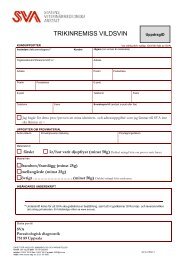
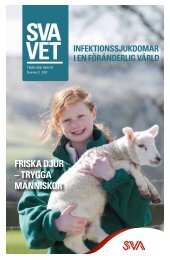
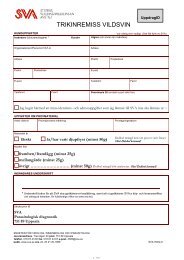
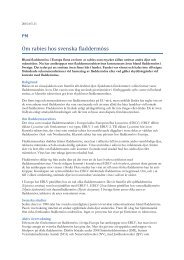
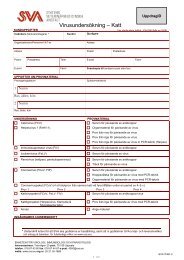
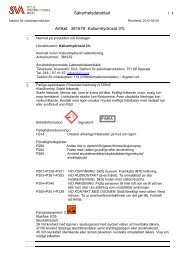
![Uppsala nfo z NRL pro kampylobaktery .ppt [režim kompatibility] - SVA](https://img.yumpu.com/48904877/1/190x135/uppsala-nfo-z-nrl-pro-kampylobaktery-ppt-rea-3-4-im-kompatibility-sva.jpg?quality=85)
